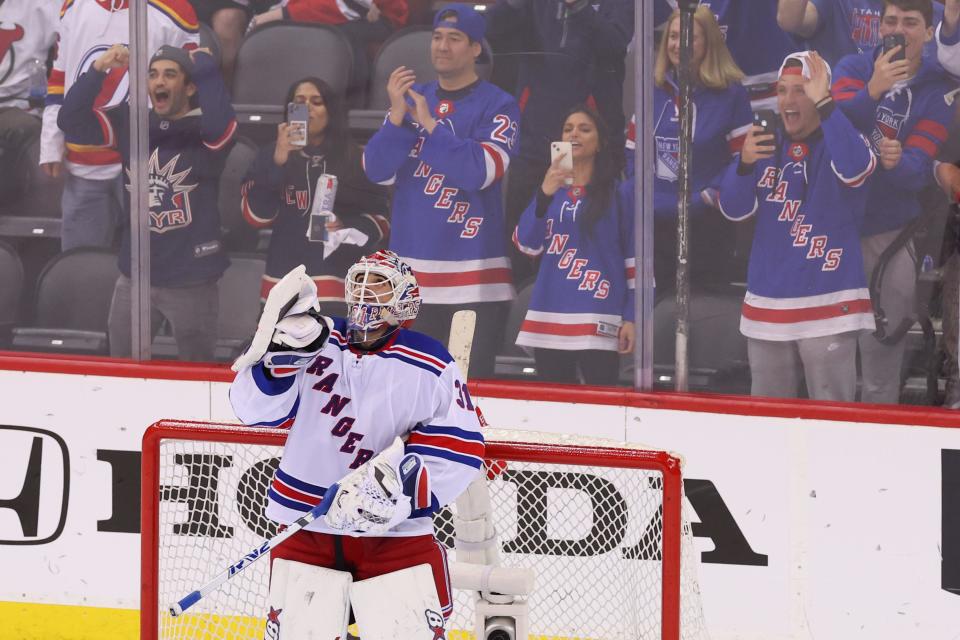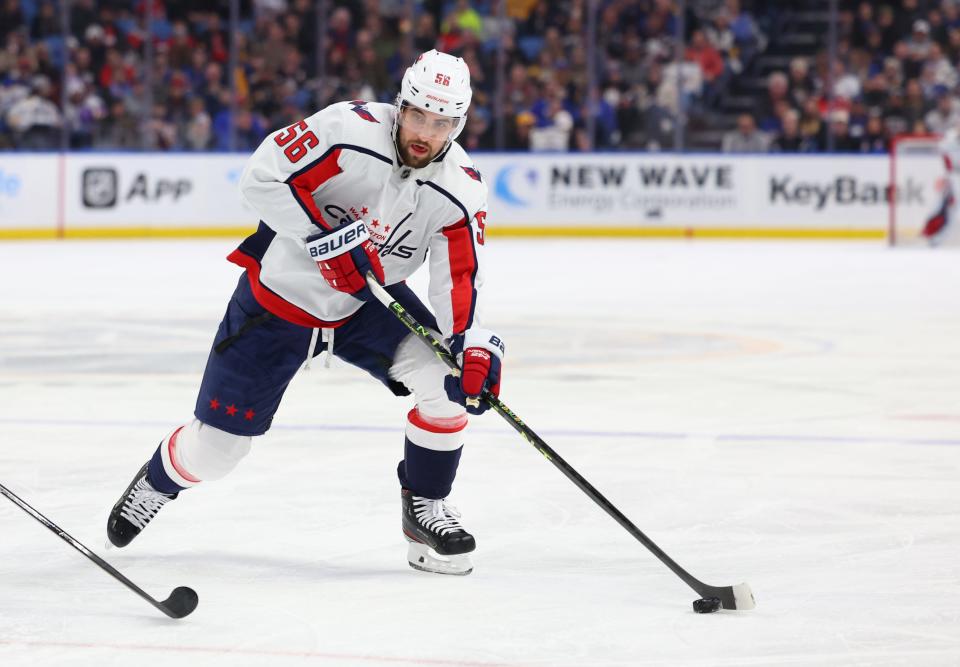NY Rangers training camp takeaways: Clear-headed Igor Shesterkin poised for a bounce back
TARRYTOWN - An introspective Igor Shesterkin emerged on the opening day of New York Rangers training camp.
With a full summer to reflect on last season, the star goalie came to a harsh realization.
"I was too hard on myself," he said Thursday from the MSG Training Center. "You remember how I was every practice. I was so mad and I didn’t want to talk much to everybody, except my family."
Whether it stemmed from the pressure of winning a Vezina Trophy two years ago or his own sky-high expectations, Shesterkin found himself in a bad headspace. And when the season didn't start the way he envisioned, it snowballed.
That frustration led to an uneven few months − at least by his lofty standards − and affected his attitude. He would often slam his stick at practice, sit alone at his locker and decline postgame interviews, making those around him feel like they were walking on eggshells.
"I was so mad at myself because I didn't play how I wanted," he said. "I hope this season I won’t be as angry. I will be more happy and enjoy talking with you guys."

As the season wore on, he began to realize that beating himself up wasn't helping.
Once he eased that burden, his on-ice results improved. Shesterkin posted a league-best .943 save percentage in his final 12 starts of the regular season, with his goals saved above average (11.75) and goals saved above expectation (17.03) during that span both ranking first by wide margins, according to Evolving Hockey. He carried that momentum into the playoffs, where he registered a .931 SV% and nearly led the out-matched Rangers past the New Jersey Devils.
The 27-year-old entered the offseason having learned a valuable lesson about his mental health. The quality time he spent with his wife, Anna, and young son, Timofey, only enhanced his newfound perspective.
"I just started to work on my brain," he said. "I think everything is a good experience if you think about it and try to (approach) it in a more positive way."
Training camp preview: Analyzing depth charts for defensemen and goalies
A refreshed Shesterkin was observed smiling and cracking jokes Thursday, which could be a great sign for the Blueshirts.
That newfound outlook doesn't diminish his drive to be great, but rather puts him in the right frame of mind to thrive.
"To see the work he puts in, his competitiveness − day in and day out − it's been fun," noted newly signed backup goalie Jonathan Quick.
Shesterkin remains, undeniably, the Rangers' most important player. No individual is capable of making such a profound impact, as he showed with his historic 2021-22 campaign.
If he can get back to that form − or at least close to it − and maintain it for a full season, the chances for a special year in New York will skyrocket.
"I’m so happy and excited about the new season," he said. "I miss hockey."
Learning a new system
While Shesterkin's importance can't be overstated, there's no escaping the reality that the team in front of him needs to be better.
The Rangers ranked 22nd in the NHL with a 48.11% xGF at five-on-five in two seasons under previous head coach Gerard Gallant, according to Natural Stat Trick, with Peter Laviolette brought in to implement a system aimed at improving those results.
That process begins in earnest Friday, when the team will take the ice for the first true practices of the 2023-24 season. (Thursday was devoted to on-ice testing.)
Peter Laviolette: New coach 'wide open' to lineup changes
Friday will be dedicated to offense, with Saturday's practices shifting to defensive philosophies. Laviolette is expecting initial growing pains, which he's willing to tolerate as long as he sees "great work ethic."
"I want it to be with pace and speed," he said. "I think we'll be bumping into each other a little bit (Friday). I think there'll be a little bit of confusion. I think there'll be some stops with the whistle to explain some things. But eventually, I think we'll get to a point where we understand that we can really start to push that pace and that speed."
The longtime bench boss stopped short of spelling out the X's and O's − "We'll bring the board in now," he joked when asked to explain his system − but Laviolette's history tells us he'll want the Rangers to be aggressive in all situations, whether it's forechecking, defending, off the rush or activating all five skaters during the offensive-zone possessions.
"I'm just curious to see how the neutral-zone stuff works. I know we had a lot of problems with that against (Laviolette's previous team, the Washington Capitals)," center Mika Zibanejad said. "It'll be nice to be on the other end of that and frustrate other teams."
Laviolette noted that his neutral-zone philosophy changes situationally − at times players will be asked to push forward, others they'll sit back and clog passing lanes − which will be part of the learning curve.
The one who's most familiar with it is defenseman Erik Gustafsson, who played for Laviolette in Washington last season before signing with the Rangers this summer.
"(He wants you) attacking and breaking out pucks and going the other way a little bit quicker," Gustafsson said. "The team we have here is very fast forwards and skilled defensemen that can make plays, and I think he wants to play the puck out from your own zone and find the middle. Whoever is the forward on the wall can bump it into the middle and (we can) come with a lot of speed through the neutral zone."
Erik Gustafsson feeling at home
Gustafsson put together one of his best seasons under Laviolette, collecting 38 points (seven goals and 31 assists) in 61 games before being traded to Toronto in February.
During his time with the Caps, he led all defensemen with a 53.91% xGF.
"He likes the D joining up (offensively)," Gustafsson said. "That’s kind of my game out there."

The 31-year-old didn't want to speculate how he'll be used in New York, but he's expected to slot in as the left-handed defenseman on the bottom pair, likely next to Braden Schneider. That spot has been a revolving door the last few seasons, with the Rangers hopeful they found the right piece to fill it.
That opportunity, along with the presence of a coach he's had success under and a friend from back home in Zibanejad − he said they met in Sweden "14 or 15 years" − factored into Gustafsson's decision to ink a one-year, $825,000 deal.
"(Laviolette) was one of the biggest reasons, obviously, but I think also the group of guys they have here," Gustafsson said. "I talked to Mika a lot before I signed, and we were talking through how the team was in the locker room and all that stuff. I just got so many positive things from it. We have a couple of older guys that have joined now, too, with great experience in the NHL and for the playoffs. We’ve got the young core out there that's very skilled, and I’m looking forward to those young guys coming up here."
Laviolette talks analytics
Laviolette is preparing to enter his 22nd season as an NHL head coach and certainly brings some old-school tendencies. But the 58-year-old says he's also open to new ways of thinking.
Ultimately, he's striving to strike the balance between using new-age statistics to make good decisions without losing sight of the human element.
"I want analytics to give me information that I can use to help me make my team better," he said. "Inside of that, I don't think that you can get just completely hung up on numbers. I do think that there's a feel to the game. There's my eyes (and) my knowledge of a person or a player."
"I'll give you a for instance. If your top centerman is 65% in the faceoff circle, or 62% in the faceoff circle, and he's having a tough night and there's one faceoff that has to be won and it's his strong side and you believe in this one person, you don't have to just say, ‘I'm going to go against it.’ You may, and I think you have to take that information in and analyze it, and then make a hockey decision on what you want to do. I do agree that it continues to evolve. The information is awesome – things that I could never think of or come up with a way to formulate. And from there, you still have to take that information, you have to use it and you still have to make hockey decisions, as well."
Vincent Z. Mercogliano is the New York Rangers beat reporter for the USA TODAY Network. Read more of his work at lohud.com/sports/rangers/ and follow him on Twitter @vzmercogliano.
This article originally appeared on Rockland/Westchester Journal News: NY Rangers camp takeaways: Igor Shesterkin poised for a bounce back

